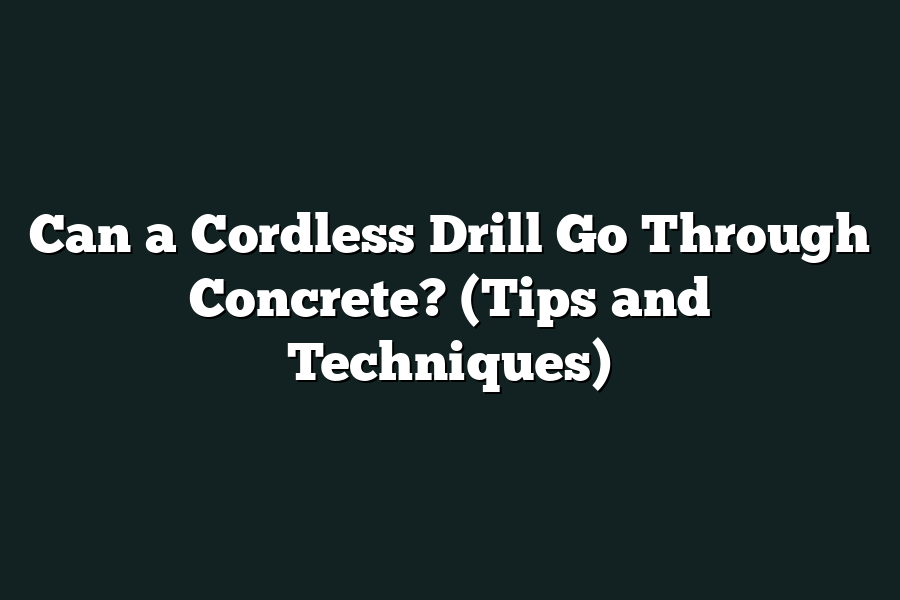Yes, a cordless drill can go through concrete, but it requires the right drill bits and a powerful drill model. You will need masonry drill bits specifically designed for drilling through tough materials like concrete. Additionally, using a hammer drill setting on a cordless drill can provide the extra power needed to effectively drill into concrete surfaces. It’s important to use proper technique and take breaks to prevent overheating the drill motor.
Curious if your cordless drill can handle concrete?
Get ready to master the art of concrete drilling with our expert guide.
Learn how to choose the right tools, apply essential techniques, and prioritize safety for successful drilling.
Let’s dive in and level up your concrete drilling skills!
Table of Contents
Understanding the Importance of the Right Tools – Choosing the Best Masonry Drill Bit
When it comes to tackling tough materials like concrete with a cordless drill, having the right tools at your disposal can make all the difference.
One key component in this equation is selecting the best masonry drill bit for the job.
Why Choosing the Right Drill Bit Matters
Imagine trying to carve a sculpture with a butter knife – it simply wouldn’t work.
Similarly, attempting to drill through concrete with the wrong type of drill bit is a recipe for frustration and potential damage to both your materials and equipment.
The Role of Masonry Drill Bits
Masonry drill bits are specifically designed to bore through hard materials like concrete, brick, and stone.
Unlike standard drill bits, which may struggle or even break when faced with such surfaces, masonry drill bits feature a carbide tip that can withstand the hardness of these materials.
Factors to Consider When Choosing a Masonry Drill Bit
Size Matters: Selecting the right size of drill bit is crucial for the success of your drilling project. A bit that is too small may not be able to penetrate the concrete effectively, while one that is too large can lead to cracks or an uneven finish.
Quality is Key: Investing in high-quality masonry drill bits can save you time, effort, and money in the long run. Cheaper alternatives may wear out quickly or fail to provide the precision required for drilling through tough materials.
Compatibility with Your Drill: Ensure that the masonry drill bit you choose is compatible with your cordless drill. Check the drill’s chuck size and the shank diameter of the drill bit to ensure a secure fit.
Surface Finish: Consider the type of finish you desire on your concrete surface. Some masonry drill bits are designed for smooth drilling, while others may create a more textured finish.
The Importance of Sharpness
A sharp drill bit is essential for successful drilling through concrete.
Dull bits not only make the task more difficult but can also generate excess heat, potentially leading to damage to the drill bit and the material being drilled.
Real-Life Example
Let’s say you’re working on a DIY project to install shelves in your garage.
You grab your cordless drill and a masonry drill bit, but soon realize that the bit is struggling to make progress through the concrete wall.
By investing in a high-quality, appropriately sized masonry drill bit, you can ensure a smoother drilling experience and better results for your project.
Choosing the best masonry drill bit may seem like a small detail, but it can have a significant impact on the success of your drilling projects.
By considering factors such as size, quality, compatibility, and sharpness, you can enhance both the efficiency and effectiveness of your cordless drill when working with tough materials like concrete.
Power Up – Selecting a Cordless Drill with Sufficient Power and Torque
When it comes to drilling through concrete with a cordless drill, having the right amount of power and torque is crucial.
In this section, we’ll explore how to select a cordless drill that can tackle the tough job of drilling into concrete.
Why Power and Torque Matter
Concrete is a dense and hard material, so your cordless drill needs to have the power and torque to penetrate through it effectively.
The power of a cordless drill is measured in volts, with higher voltage drills typically delivering more power.
For drilling into concrete, it’s recommended to use a drill with at least 18 volts to ensure sufficient power.
Torque, on the other hand, is the rotational force of the drill.
When drilling into tough materials like concrete, high torque is essential to avoid stalling or overheating the drill.
Look for a cordless drill with high torque ratings to ensure smooth and efficient drilling performance.
Choosing the Right Voltage
When selecting a cordless drill for concrete drilling, opting for a higher voltage model is usually the way to go.
Higher voltage drills provide more power, allowing them to tackle tough materials with ease.
For concrete drilling, experts recommend using a cordless drill with at least 18 volts to ensure adequate power for the job.
Importance of Torque
Torque plays a significant role in the drilling performance of a cordless drill, particularly when it comes to tackling challenging materials like concrete.
High torque allows the drill to maintain speed and power under resistance, preventing stalling and overheating.
When drilling into concrete, look for a cordless drill with high torque ratings to ensure smooth and efficient operation.
Case Study: Impact of Power and Torque
A study conducted by ToolTally compared the drilling performance of cordless drills with varying power and torque ratings on concrete surfaces.
The results showed that drills with higher voltages and torque were able to drill into concrete more efficiently, with shorter drilling times and less strain on the motor.
Expert Recommendation
According to experts at ThisOldHouse, when choosing a cordless drill for concrete drilling, it’s essential to prioritize power and torque over other features.
Opting for a drill with higher voltage and torque ratings will ensure that you have the necessary strength and stability to tackle concrete surfaces effectively.
when selecting a cordless drill for drilling into concrete, prioritize power and torque to ensure efficient and successful drilling operations.
Choosing a drill with higher voltage and torque ratings will provide the strength and stability needed to penetrate through tough concrete surfaces with ease.
Techniques for Success – Applying Steady Pressure and Working Methodically
When it comes to drilling through concrete with a cordless drill, it’s essential to master the right techniques for successful results.
One of the key methods involves applying steady pressure and working methodically to ensure the task is completed effectively and efficiently.
Applying Steady Pressure
To effectively drill through concrete with a cordless drill, applying steady pressure is crucial.
This technique helps maintain control and precision during the drilling process.
Here are some tips on applying steady pressure:
Start Slow: Begin drilling at a slow speed to establish a pilot hole without putting too much pressure on the drill.
Increase Pressure Gradually: As you continue drilling, gradually increase the pressure on the drill to penetrate the concrete surface.
Maintain Consistency: Keep the pressure steady and consistent throughout the drilling process to avoid damaging the drill or the concrete.
Use Proper Posture: Position yourself correctly to apply downward pressure in a controlled manner, ensuring a smooth drilling operation.
Working Methodically
Working methodically is another key aspect of successfully drilling through concrete with a cordless drill.
This approach involves planning and executing the drilling process strategically.
Here’s how to work methodically:
Mark the Drilling Spot: Begin by marking the exact spot where you need to drill to avoid any mistakes or inaccuracies.
Choose the Right Drill Bit: Select a drill bit that is specifically designed for drilling through concrete to ensure efficient and effective penetration.
Divide the Task: Break down the drilling process into smaller sections, drilling one section at a time to manage the workload effectively.
Clear Debris Regularly: Clear away debris and dust from the drilled holes periodically to maintain visibility and ensure accurate drilling.
By combining the techniques of applying steady pressure and working methodically, you can enhance your drilling capabilities and achieve successful results when using a cordless drill on concrete surfaces.
Remember, practice makes perfect, so don’t be afraid to hone your skills through hands-on experience.
In the next section, we’ll delve into the importance of using the right drill bits for concrete drilling and how it can impact your overall drilling performance.
Stay tuned for more expert tips and insights!
Safety First – Protective Gear and Precautions When Drilling Through Concrete
When it comes to drilling through concrete with a cordless drill, safety should always be the top priority.
Concrete is a hard and dense material that can pose risks if proper precautions are not taken.
In this section, we’ll discuss the essential protective gear and precautions you need to consider before drilling into concrete.
Protective Gear
To ensure your safety during the drilling process, it’s vital to wear the appropriate protective gear.
Here are the essential items you should have on hand:
Safety Glasses: Protect your eyes from dust, debris, and potential flying particles while drilling.
Dust Mask or Respirator: Prevent inhaling harmful concrete dust particles by wearing a dust mask or respirator.
Ear Protection: Shield your ears from the loud noise generated by the drilling action to prevent hearing damage.
Gloves: Keep your hands safe from any sharp edges or vibrations that may occur during drilling.
Precautions Before Drilling
Before you start drilling into concrete, there are several precautions you should take to ensure a safe and successful drilling operation:
Locate Utility Lines: Before drilling, ensure you know the location of any utility lines (such as electrical wires or water pipes) within the concrete to avoid damaging them.
Use the Right Drill Bit: Make sure to use a carbide-tipped masonry drill bit designed specifically for drilling into concrete. Using the wrong bit can result in damage to your drill or ineffective drilling.
Secure Workpiece: Ensure the concrete surface you’re drilling into is securely held in place to prevent any movement that could cause accidents.
Start Slowly: Begin drilling at a slow speed to create a pilot hole before increasing the speed for more efficient drilling.
Apply Firm Pressure: Maintain a steady and firm pressure on the drill to prevent it from slipping or bouncing on the concrete surface.
Take Breaks: Drilling into concrete can be physically demanding. Take regular breaks to prevent fatigue and ensure accuracy in your drilling.
By following these protective gear requirements and precautions, you can minimize the risks associated with drilling through concrete with a cordless drill and ensure a safer and more effective drilling experience.
In the next section, we’ll dive deeper into the technical aspects of using a cordless drill for concrete drilling and explore best practices for achieving optimal results.
Stay tuned!
Final Thoughts
Tackling a concrete drilling project with a cordless drill is absolutely achievable with the right tools and techniques at your disposal.
By selecting the best masonry drill bit, opting for a cordless drill with adequate power and torque, applying steady pressure, and prioritizing safety measures, you’re well-equipped to take on the task successfully.
Now armed with this newfound knowledge, why not put it into action and start your next concrete drilling project with confidence?
Remember, safety first, power up, and drill away!
Happy drilling!

